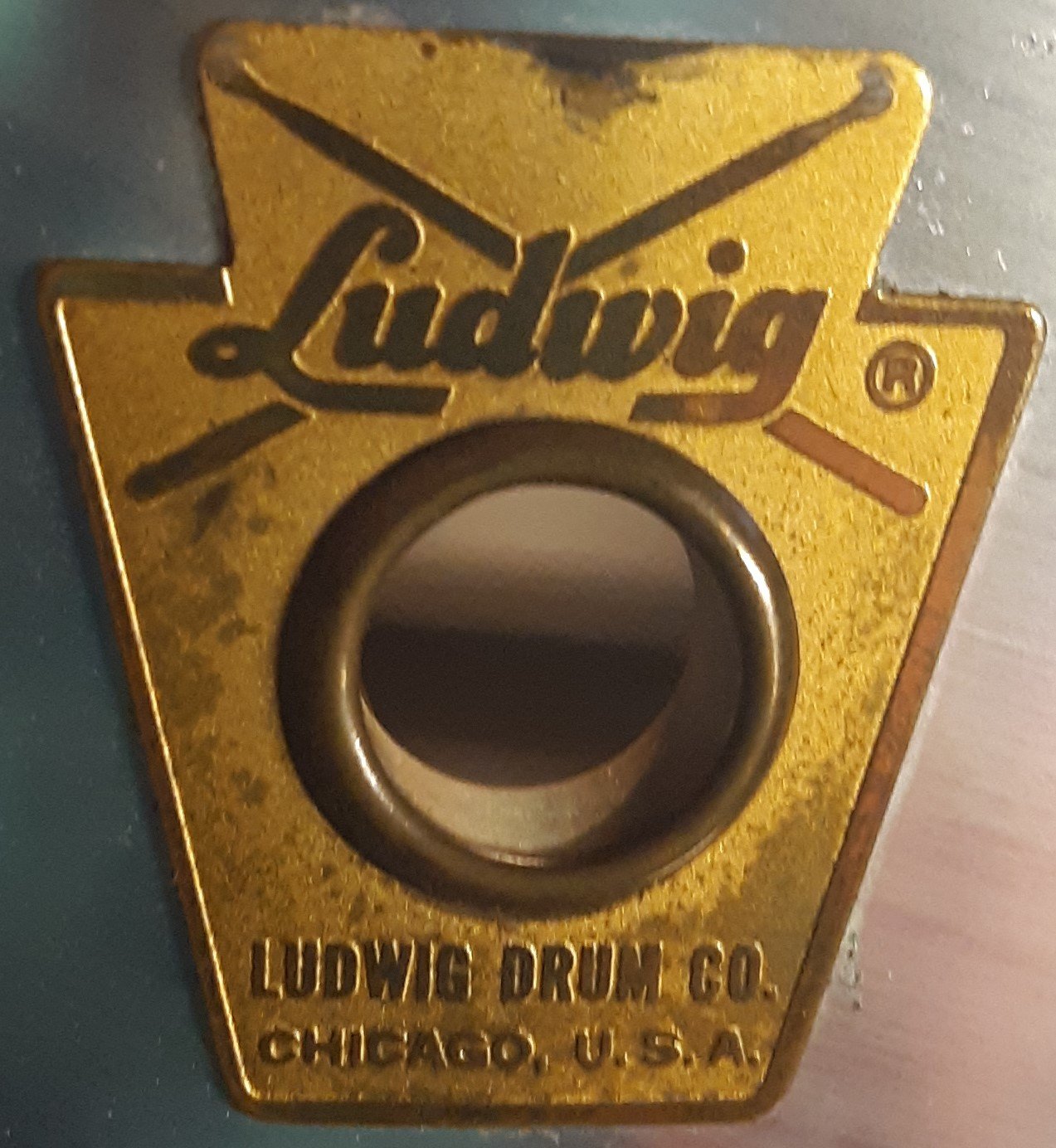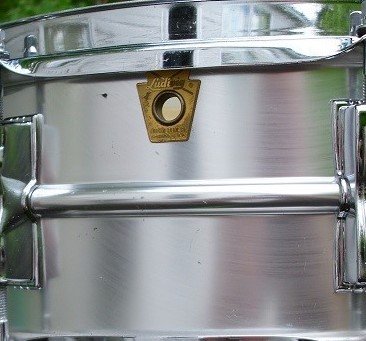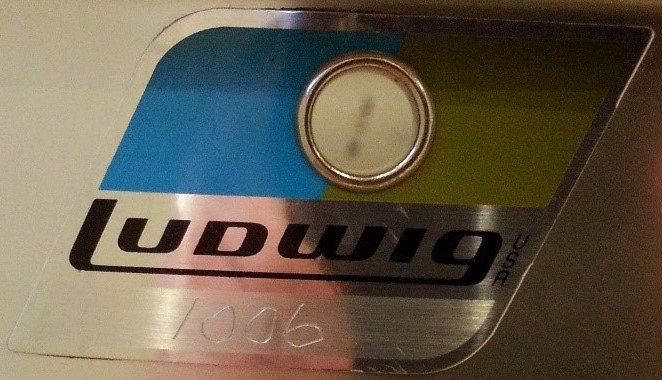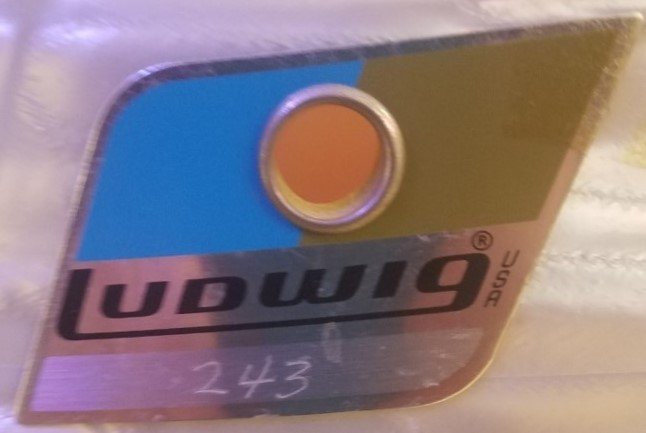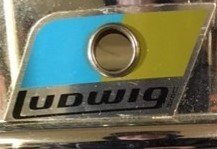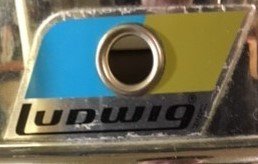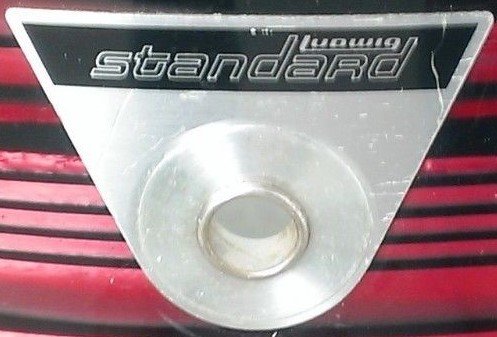Thanks to Bun E Carlos, Tim Hornbeck, Mike Layton and Kevin Oppendike who contributed pictures. (1)
A vintage Ludwig drum made after 1963 that does not have a serial number creates much confusion and spirited debate. Few today agree on why or how drums escaped the factory with badges lacking serial numbers. Theories are often strongly expressed but weakly supported. Although speculation and conjecture are a part of the wonderful world of vintage drums, many incorrect statements become truth through repetition. This study looks at 332 vintage Ludwig drums that have badges without serial numbers. The hope is that by using improved information better explanations can be developed.
To place the unnumbered badges in proper context, we introduce each badge and discuss its position in the serial number scheme used by Ludwig.(2) We then explore variations of those badges without serial numbers and sort them into distinct groups.
Keystone Badge without Trademark Registration Symbol or Serial Number – “Pre-Serial”:
From about October 1960 to November 1963, Ludwig produced drums bearing a small keystone badge without a trademark registration symbol (®) or a serial number.(3) This is referred to as the “Pre-Serial” badge.(4) While these drums are special because they are vintage drums, they are not “special” or unique because they lack serial numbers. Ludwig simply did not use serial numbers at this time. Some modern reproductions of the Pre-Serial badge exist and period-correct badges are sometimes switched, so one should be careful to verify that the badge is original to the drum to which it is attached to avoid drawing incorrect conclusions.
Pre-Serial Badge. Photo by Gier
Keystone Badge without Trademark Registration Symbol but with Serial Number – “K1”:
When Ludwig starts using serial numbers, they are on the same style of badge as the Pre-Serial badge.5 This is referred to as the “K1” badge. The earliest date stamp documented on a drum with a K1 badge is October 10, 1963. During October – November 1963, and occasionally afterwards, a drum may have received either the Pre-Serial or the K1 badge. At some point in the second half of 1964, and at about serial number 59500, the trademark registration symbol was added to the Keystone badge.(6) This brings the K1 badge to an end.
K1 Badge. Photo by Gier
Keystone Badge without Trademark Registration Symbol or Serial Number – “Blank K1”:
Because the same underlying style of badge was used for both Pre-Serial and K1 badges, a K1 badge without a serial number is likely just a Pre-Serial badge. Alternatively, it could also be a modern reproduction. It is likely not a rare example of a badge that failed to receive a serial number it was supposed to receive.
Keystone Badge with Trademark Registration Symbol and Serial Number – “K2”:
When Ludwig added the trademark registration symbol to the right of the script Ludwig on the K1 badge, they created what is referred to as the “K2” badge. The K2 badge starts at about serial number 59500 and continues through about serial number 749000. The vast majority of the K2 badges appear on drums with date stamps from late 1964 through November 1969.
K2 Badge. Photo by Gie
Keystone Badge with Trademark Registration but without Serial Number – “Blank K2”:
K2 badges without serial numbers are referred to as “Blank K2” badges. There are relatively few Blank K2 badges documented. Modern reproductions of the K2 badge are available and sold openly and frequently. The reproductions do not have serial numbers, so look like Blank K2 badges. One should be especially careful to verify that the badge is original to the drum to which it is attached to differentiate between legitimate Blank K2 badges and modern reproductions.
Blank K2 Badge. Photo by Mike Layton High Placement of Vent Hole. Photo by Mike Layton
Twenty-one different drums with Blank K2 badges are documented. Seventeen have date stamps from September 1, 1970 through September 8, 1970. One is documented with a 1970 date stamp (month and day are not readable) and three others are on drums without reported date stamps but possessing physical characteristics consistent with 1970 manufacture.(7) All 21 of these drums are metal shelled drums – Acrolites, Supraphonics and Super-Sensitives. Most are reported to have the vent hole placed higher on the shell, which can result in the top of the badge being covered.(8) The higher vent hole location is consistent with use of Blue/Olive badges. One caution - with only 21 examples, and only 17 with complete date stamps, one cannot definitively conclude that all legitimate Blank K2 badges are on metal drums or have September 1-8, 1970, date stamps. More reports of drums with Blank K2 badges are needed to draw solid conclusions.(9)
Blue/Olive Badge without Trademark Registration Symbol but with Serial Number – “BO1”:
In very late 1969, Ludwig switched from the K2 badge to a parallelogram shaped badge with blue and olive coloring. The upper right and lower left corners are pointed. The initial blue and olive badge did not have the trademark registration symbol on it. This is referred to as the “BO1” badge. The serial number sequence in use on K2 badges continues with BO1 badges, with the transition point being about number 749000. Serial numbers continue up to about 945000 on BO1 badges in about the middle of 1972.
BO1 Badge. Photo by Gier
Blue/Olive Badge without Trademark Registration Symbol or Serial Number – “Blank BO1”:
One hundred and thirty-nine BO1 badges without serial numbers are documented. These are referred to as “Blank BO1” badges. Of these, 114 have a date indicator of some sort – 84 with date stamps and 30 with Date Codes – while 25 do not. Eighty of the date stamps are from 1970 and four from May 1971. A large group of these (59) are date stamped from September 8, 1970 to October 10, 1970, while the 21 remaining drums from 1970 are spread from April 3, 1970 through December 16, 1970. The Date Codes on the 30 drums with them (56717, 58717, 59717 and 60717) appear to date from 1971, starting in about May of that year.(10) The remaining 25 Blank BO1 badges without date indicators have physical characteristics consistent with early 1970s drums (e.g.: P-85 12-hole throw-offs, clear varnish interiors).
Blank BO1 Badge. Photo by Mike Layton
Of the 136 drums with Blank BO1 badges where the shell type is known, shell type is distributed between metal (38) and wood (98). The metal shelled drums with Blank BO1 badges have vent holes located well above the center bead, so the full-sized badge fits easily. About 7.2% (139/1,926) of the total BO1 badges recorded are Blank BO1 badges.
The large concentration of Blank BO1 badges in September 8 -October 10, 1970 is particularly interesting. As noted earlier, the Blank K2 badges have date stamps date from September 1-8, 1970. There is also a noticeable absence of reports of drums with serial numbers with date stamps from September 1 – October 9, 1970. This strongly suggests that Blank badges were used in lieu of badges with serial numbers during this time. The reasons for this six-week phenomenon, which occurred almost a year after the K2 badge was discontinued and the BO1 badge was introduced, are not known.
Blue/Olive Badge with Trademark Registration Symbol and Serial Number – “BO2”:
In about mid-1972 and at about serial number 945000, Ludwig added the trademark registration symbol to the BO1 badge. The result is referred to as the “BO2” badge. Disregarding the trademark registration symbol, or more likely not noticing that some had it while others did not, many group the BO1 and BO2 badges together under the combined name “Pointy Corner B/O Badge.” The BO2 badge continued to be used through about 1981 and about serial number 2230000. Note that the next badge, with rounded corners and referred to as the BO3 badge, appears in about 1978 and at about serial number 1880000. BO2 and BO3 badges are used concurrently for a few years.
BO2 Badge. Photo by Gier
Blue/Olive Badge with Trademark Registration Symbol but without Serial Number – “Blank BO2”:
Fifty-three drums are documented with BO2 badges without serial numbers, referred to as “Blank BO2” badges. Because Ludwig ceased date stamping its drums before the debut of the BO2 badge, date stamps are not available to assist in the evaluation of the Blank BO2 badges. It is believed that the Blank BO2 badges date from 1972 through the late 1970s. The Blank BO2 badges are found on drums with Granitone interiors, drums with 2-hole black-faced P-85 throw-offs, Vistalites and concert toms, which are all indicators that these drums are from 1972 or later. The owner of one drum with a Blank BO2 badge possesses his original receipt dated May 4, 1978. The Blank BO2 badges are distributed between metal (27), wood (17) and Vistalite (9) shelled drums. The metal shelled drums with Blank BO2 badges have vent holes located well above the center bead. Blank BO2 badges represent about 1.5% (53/3,507) of the BO2 badges recorded. Modern reproduction BO2 badges without serial numbers are readily available. The proliferation of reproduction BO2 badges may impact the integrity of the data about Blank BO2 badges and blur the already somewhat unclear situation. Efforts were taken to remove drums with reproduction badges from the analysis.
Blank BO2 Badge. Photo by Mike Layton
Blue/Olive Badge with Etched Numbers:
Five BO1 and ten BO2 badges are documented which have etched or hand-engraved numbers in the area where stamped serial numbers were normally placed. These look like Blank BO1 and Blank BO2 badges with added numbers. These are referred to as “Etched BO1” and “Etched BO2” badges. It is unclear if any or all of these left the factory with the etched numbers. Two Etched BO1 badges (numbers 1005 and 1006) are date stamped in June 1970 and three Etched BO1 badges (numbers 102, 136, 181) are date stamped in September 1970. Seven Etched BO2 badges (numbers 169, 188, 189, 198, 199, 243, and 1028) have a similar style of etched numbers. Three other Etched BO2 badges have crudely etched numbers (122868, 0507761, WSB 82283) which appear to have been added by owners. The similar appearance and the relative proximity of the 12 three- and four-digit etched numbers reported above point to these being applied by the same party, likely Ludwig.
Some vintage drum enthusiasts have suggested that the etched numbers identify these drums as prototypes, dealer samples or drums specially made for endorsers. However, except for the etched numbers, there is nothing remarkable or out of the ordinary about any of these drums. For example, five of them are ordinary Acrolites. The 15 drums with etched numbers have a mix of wood (6), metal (6), Vistalite (2) and unknown (1) shells. It is not clear why they received etched numbers or what the etched numbers mean.
Etched BO1 Badge. Photo by Tim Hornbeck Etched BO2 Badge. Photo by Kevin Oppendike
Because they are distinctly different, these etched badges are not included in the discussion of Blank BO badges above. If these were considered to be Blank BO1 and BO2 badges, they appear to fit in well in the timeline with the other Blank BO badges. For example, the three Etched BO1 badges on drums with date stamps from September 1970 coincide with the largest concentration of Blank BO1 badges.
Trimmed Blue/Olive Badges - “Trimmed BO1” and “Trimmed BO2”:
The majority of metal-shelled drums made after 1969 badge switch were drilled with the necessary higher vent hole location and were given intact, full-sized BO badges. However, at various times shells drilled with a lower vent hole location appear. For these, Ludwig trimmed or cut the bottom portion of BO1 and BO2 badges so they would fit. These are referred to as “Trimmed BO1” and “Trimmed BO2” badges, respectively. Because the bottom portion is missing, it is unknown if these trimmed badges were BO1 and BO2 badges with serial numbers, Blank badges or modern reproduction BO2 badges. (11)
Trimmed BO1 Badge. Photo by Bun E Carlos Trimmed BO2 Badge. Photo by Bun E Carlos 6
Fifty drums with Trimmed BO1 badges are documented, representing about 2.6% (50/1,926) of the BO1 badges recorded. Thirty-three of these have reported date stamps, seventeen do not. The 33 drums with date stamps fall into three groups – 16 drums date stamped shortly after the introduction of the BO badge (four in December 1969, 12 from January 1 through March 1970); six drums with dates spread from April to December 1970; and, following a nine-month hiatus, 11 drums with dates spanning from October 1, 1971 through December 9, 1971.(12) From the first two groups, two are known to be Ludalloy, three are known to be brass, and the type of metal is not known on the remaining 17. In the third group, nine of 11 of the drums are reported as chrome plated brass shells while the metal is not known for the other two. The 17 drums without reported date stamps are a mixture of Ludalloy and brass shells. Many of the brass drums are reported to have a “B” stamped above the tone control knob.
“B” above Tone Control. Photo by Bun E Carlo
Sixteen drums with Trimmed BO2 badges are documented, none with date stamps. About 0.46% (16/3,507) of the total of BO2 badges recorded are Trimmed BO2 badges. All of them have chrome plated brass shells. Eleven of these have the 2-hole version of the P-85 throw-off, which were not available until about 1973, so were made in 1973 or later or have non-original throw-offs. The other five drums have replacement throw-offs.
All 66 of these Trimmed BO1 and BO2 badges appear on five-inch depth metal-shelled drums with center beads (Acrolites, Supraphonics and Super-Sensitives) where the vent holes are located too close to the bead to fit the full-sized Blue/Olive badge. One common explanation for the Trimmed BO badges is that Ludwig was using “leftover shells.” The theory is that these shells were drilled for Keystone badges, so the BO badges had to be trimmed to fit in the available space. This explanation may be correct, particularly for December 1969 – March 1970 drums, and could explain the few shells dated later in 1970. However, this “leftover shells” explanation makes less sense as time passes, particularly for drums date stamped in late 1971 with Trimmed BO1 badges or made in 1972 or later with Trimmed BO2 badges. This “leftover shells” explanation would require that the 1971 and later drums had shells which were not used for multiple years after their manufacture. This is certainly possible but seems less likely the longer the delay. Alternatively, some new shells could have been manufactured with the “wrong” vent hole location years after the switch to the BO badge, making them “misdrilled shells.” Some combination of these two theories may be a more reasonable explanation.
It seems relevant that all the drums with Trimmed BO1 badges from late 1971 and all reported with Trimmed BO2 badges are chrome plated brass shells. Most are reported as having a “B” stamped above the tone control knob while others are simply reported to be brass. There is not yet enough data to proclaim that all drums made after 1970 which received Trimmed BO badges have brass shells. It is possible that more drums with Trimmed BO badges from the late 1971 – mid-1970s time period will emerge and some of them will not have brass shells. This is another situation where more reports are needed before we can confidently express an explanation. However, if additional data shows that all drums receiving trimmed badges after 1970 had brass shells, it could be a helpful identification tool. It seems redundant to use both the “B” stamp and a Trimmed badge to identify brass shells, so I suggest that use of Trimmed badges on brass shells may not have been intended as a way to identify the brass shells. It may have been simply due to the more practical reason that full-sized badges would not fit.
There are stories of a batch of 100 brass shelled Supraphonics produced in the early 1970s.(13) While most of the Ludwig “only 100 made” stories have not proven to be correct, (14) 1970s brass Supraphonics certainly do exist. Based upon examples above, they all have Trimmed BO1 and BO2 badges. These brass snares are documented with date stamps from 1969, 1970 and 1971, and others (those receiving Trimmed BO2 badges) are known to be from 1972 and after. The multi-year span seems inconsistent with production of a single batch of 100 shells. It is also difficult to understand why the vent holes would have been drilled too low to fit the full-sized Blue/Olive badge. Some suggest that the brass shells were another group of “leftover shells” from the early 1960s, but these shells had a “B” stamped above the tone control knob and are generally thought to be lighter, spun shells not used in the 1960s.
Although the reasons why the badges were trimmed are not known, based upon the information about Trimmed badges detailed above, the following timeline is developed:
Parallelogram Badge without Blue or Olive Paint – “Blank Silver” and “Etched Silver”:
Eleven drums with parallelogram shaped badges with pointed corners but lacking blue and olive coloring are recorded. These have the trademark registration symbol, so are most similar to the BO2 badge. They are referred to as “Silver” badges. Two of these lack serial numbers (“Blank Silver” badges), while nine have etched numbers (“Etched Silver” badges), much like the etched numbers mentioned on BO1 and BO2 badges above. Etched numbers recorded to date are: 377, 382, 431, 434, 437, 585, 611, 69x(15) and 751. They appear on Black Beauty (3) and Supraphonic (5) snare drums and one wrapped wood bass drum. These drums appear to date from the 1970s, based upon their hardware, some owner recollections about original purchase dates and the reintroduction of Black Beauty model snare drums in 1977. Etched number 431 was the subject of a 2014 article in Not So Modern Drummer where several theories about the Silver BO badges are discussed.(16) It is suggested that the Silver BO badges may have been used for prototypes. The examples documented above do not appear to be prototypes.
Etched Silver Badge. Photo by Kevin Oppendike
Ludwig Standard Badge without Serial Number – “Blank Standard”:
To cover all vintage Blank badges, one must address the badges seen on Ludwig Standards, Ludwig’s second tier line of drums from 1968-1973. Of the 1,246 drums on the list of Standards, 27 have badges without serial numbers. Four have date stamps from December 1970 and eight have date stamps from February through June 1971. Three have Date Code 56717, which is associated with 1971 manufacture. The remaining dozen do not have date indicators reported. There are no trimmed Standard badges documented, but metal Standard snares did not have raised center beads nor was the location of the vent hole changed during the six-year run of Standards. No theory is offered to explain why Ludwig Standards appear without serial numbers.
Standard Badge. Photo by Gier Blank Standard Badge. Photo by Gier
Later Ludwig Blank Badges:
No reports of the rounded corner BO3 or BO4 badges of the later 1970s and early 1980s are documented without serial numbers. There are a few reports of badges without serial numbers on the Large Keystone Chicago Badge, the Large Keystone Monroe badge, the Black/White parallelogram badge, the Combo badge and the Educator badge. No explanation is offered for the lack of serial numbers on these newer badges.
Modern B-Stock Drums and the Return of the Trimmed BO Badge:
More recently, Ludwig has sold modern drums with Trimmed Blue/Olive badges. The badge on these drums is not a vintage BO1 or BO2 badge, but instead a reissue of the Blue/Olive badge. It has a rounded corner at the top right, much like the BO3 and BO4 badges. These drums are offered as B-Stock and have some relatively minor blemish that keeps the drums from meeting Ludwig’s appearance criteria for full priced product. The re-emergence of the trimmed BO badge causes some confusion. Many see a vintage drum with a trimmed badge and assume that it is a factory second based upon the modern use of the trimmed badge. This is a situation of a little knowledge leading to incorrect conclusions. During the 1970s, Ludwig did not sell drums as B-stock nor did the trimmed badge indicate that the drum to which it was attached was a second quality instrument.
Summary:
Study of 332 drums with badges without serial numbers shows that many different scenarios occurred. To distinguish and properly understand them, it is important to:
understand and distinguish between the different types of badges involved,
look at the time period when each type of unnumbered badge appears, and
stop relying upon unsupported theories to avoid perpetuating untrue legend and lore.
The total number of each style of Blank, Trimmed and Etched badge are shown below, broken out by year. To provide additional perspective, numbers for 1970 are further subdivided to emphasize when different scenarios occurred.
Significant Time Periods:
December 1969 - March 1970 - Initial unnumbered badges were Trimmed BO1.
April 1970 - First documented Blank BO1 badges appear.
September 1 - October 9, 1970 - High concentration of Blank K2 and Blank BO1 badges.
1971 and later - Trimmed BO1 and BO2 badges are only on brass shelled drums.
Observations:
1. About ten percent (194/1926) of the BO1 badges recorded do not have serial numbers. This includes 139 Blank BO1, 50 Trimmed BO1 and five Etched BO1 badges. About 196,000 serial numbers are thought to have been used on BO1 badges (749000 – 945000), so there may be 19,600 or so BO1 type badges without serial numbers. Therefore, early 1970s Ludwig drums with Blue/Olive badges without serial numbers are fairly common.
2. Except for a brief period in September/October 1970, Blank badges were used concurrently with badges with serial numbers.
3. Because Ludwig stopped placing date indicators inside its drums in 1972, it is difficult to further refine information about Blank BO2, Trimmed BO2, Etched BO2 and Silver badges.
4. Trimmed badges were trimmed to fit on metal shelled snare drums with center beads. Some but not all of those shells are brass. None of the vintage drums with Trimmed badges are seconds or “B- Stock.”
Myths and Truths about Ludwig Badges without Serial Numbers:
This study of badges without serial numbers helps to explain what was actually happening and disprove a few frequently repeated myths about vintage Ludwig drums:
Myth #1: Blue/Olive badges without serial numbers were used to fill the gap between the end of Keystone badges and the beginning of Blue/Olive badges.
Truth: This myth may have started with a convoluted misreading of a parenthetical comment in The Ludwig Book, in which Rob Cook states: “(A few drums were made between the keystone and B&O badges which were fitted with no badge at all, just a grommet on the air vent.)”(17) Cook says nothing about Blank BO badges being used during this switch-over. In fact, he places the Blank BO badges later in time. Based upon the drums in this study, when the BO1 Badge was introduced, Trimmed BO1 badges was used concurrently with BO1 badges with serial numbers. The vast majority of BO1 badges without serial numbers appeared well after the badge switch-over.
Myth #2: Ludwig badges did not have serial numbers in 1970.
Truth: The origin of this myth appears to be Cook’s entry in his dating chart for 1970 as “out of sequence, unnumbered.”(18) However, the accompanying text states: “‘Unnumbered’ does not mean that all drums made in that year were numberless, just that we can verify the existence of drums made in that year which have no serial number.” Many who have seen Cook’s chart have never seen, or have ignored, the clarifying language which accompanied it. There are many drums with 1970 date stamps with serial numbers. They are not particularly out of sequence, either.(19) Blue/Olive badges without serial numbers (both Blank and Trimmed) were generally used concurrently with Blue/Olive badges that possessed serial numbers. The six weeks from September 1 – October 9, 1970 was the only time identified when Ludwig almost exclusively used badges without serial numbers.
Myth #3: A corollary to the Myth #2 - All unnumbered badges come from 1970.
Truth: Once again, reading comprehension seems to be an issue. In addition to the “out of sequence, unnumbered” entry for 1970, Cook states: “In 1970 and early 1971 a few “blank” B&O badges (no serial number) were installed. Blank B&O badges were installed intermittently later in the 1970s.”(20) Based upon the drums in this study, Blank and Etched badges appear in 1970 and throughout the 1970s. Blank Standard badges appear in 1970, 1971 and maybe later. Blank BO2 Badges did not appear until about 1972. Blank Silver badges appear later in the 1970s.
Myth #4: All drums with Trimmed Badges are factory seconds.
Truth: Vintage drums with Trimmed badges are not seconds. Ludwig’s practice of selling B-Stock drums with Trimmed badges is a modern phenomenon. Unfortunately, Ludwig re-issued a version of the BO badge for its B-Stock drums, so that adds to the confusion. Telling them apart is easy, as the badge used on “B-Stock” drums has a rounded upper right corner, while the vintage Trimmed BO1 and BO2 badges have pointed upper right corners.
Description of Data Used:
This study uses lists of vintage drums compiled over the last several years. The list of main line Ludwig drums contains information from over 16,000 different drums dating from the 1960s, 1970s and early 1980s. The list of Ludwig Standard drums contains information from 1,246 drums from the 1968-1973 time period. Although these lists only document a fraction of all drums produced by Ludwig during this time period, they appear to provide a representative sample of Ludwig’s output. (21)
More Examples Wanted:
More examples of Ludwig badges without serial numbers may permit further refinement of the analysis included in this article. Please send information to Rick@GretschDrumDatingGuide.com.
1 Thanks to Bun E Carlos, Tim Hornbeck, Mike Layton and Kevin Oppendike who contributed pictures.
2 Ludwig badges were not applied to the drums in strict serial number order and the drums shells were not necessarily assembled in order by their date stamps. Nonetheless, serial numbers and date stamps provide very useful tools for discussing the chronology of vintage Ludwig drums.
3 Thanks to Ludwig Transition Badge drum enthusiast Allen Lewis for input on the October 1960 timing of the end of the Transition Badge and beginning of the Pre-Serial badge.
4 Richard E. Gier, Serial Number Based Dating Guides for Vintage Ludwig Drums, Main Line Drums 1963-1984 & Standard Drums 1968-1973, Rebeats Publications, Alma, Michigan, 2013. The badge naming conventions introduced in this dating guide are used throughout this article. Shortened descriptions are included here, but more information is available in the guide.
5 The reasoning for starting serial numbers is reviewed in this article. Richard E. Gier, “Were American Drum Manufacturers Required by Law to Use Serial Numbers During the 1960s?” June 16, 2020, available at http://www.gretschdrumdatingguide.com/other-projects.html (Project 3) and https://www.notsomoderndrummer.com/not-so-modern-drummer/2020/6/16/were-american-drum- manufacturersnbsprequired-by-law-to-use-serial-numbers-during-the-1960s
6 The timing of this event is obscured by a lack of reports of drums date stamped in the second half of 1964. It is not clear why there are so few reports of date stamps from this time period, but that gap exists in the data gathered. The best estimate for the introduction of the trademark registration symbol to the small Keystone badge is July-November 1964.
7 It is common for reports of vintage Ludwig drums to not include date stamps. Only about one-third of all drums documented in the era when serial numbers and date stamps were both in use have reported date stamps.
8 Note that several reports also exist of K2 badges with serial numbers mounted higher on the shell, often covering the serial numbers. Some were reported as blank K2 badges. In most cases, once batter hoops were removed, it was determined that the badges had serial numbers. A few reports of drums with date stamps on October 1969 with Blank K2 badges have not been confirmed so are not included in this study.
9 Approximately 689,500 (749,000 – 59,500) drums K2 badges were made with serial numbers. Over 8,300 drums with K2 badges are documented, which is about 1.2% percent of the total made. About a quarter of one percent (0.25% or 21 of 8,300) of the K2 badges documented did not have serial numbers.
10 Richard E. Gier, “Ludwig's Use of Paper Labels in 1971/1972 - Date Stamps and Date Codes,” August 31, 2020, available at http://www.gretschdrumdatingguide.com/other-projects.html (Project 5) and https://www.notsomoderndrummer.com/not-so-modern-drummer/2020/8/29/ludwigs-use-of-paper-labels-in- 19711972-date-stamps-and-date-codes.
11 One seller’s listing acknowledged that he cut a badge to fit when he pieced together the drum.
12 This may be simply due to a lack of reports or may be a meaningful phenomenon.
13 One version is detailed in a caption to a picture dated October 1972 which was posted on the Professional Drum Shop Facebook page on July 3, 2014. (https://www.facebook.com/StanKeyawa/photos/691496460900361) The note accompanying the picture states in full: “Maurie (standing) and Jan Lishon (Franks Drum Shop Chicago) visiting with Tommy Shepard and Lou Singer on couch...Behind Maurie are the famous Brass Ludwig chrome snare drums that Bob made Bill Ludwig make us after bitching about not making the brass shells since 64'...only 100 made in 5 and 6.5 x 14 ..they have a "B" under the tone control with the blue and olive badges...still see a few every now and then..... circa 1972.”
14 Other tales of “only 100 made” Ludwig drums include green Vistalites, drums in Oyster Pink Pearl, and 6.5x14” 10 lug NY Dept. of Ed. Acrolites.
15 Last digit was not revealed by the owner of the drum.
16 https://www.notsomoderndrummer.com/not-so-modern-drummer/columns/lifes-little-drumming- lessons/silver-badge-supraphonic-prototype-controversy
17 Rob Cook, The Ludwig Book, Rebeats Publications, Alma, MI, 2003, page 210.
18 Ibid.
19 The correlation between serial number and date stamp is highest in 1970, so the serial numbers documented are actually much more in sequence than in any other year studied between 1963 and 1972.
20 Ibid Cook
21 Approximately 1.25% (9,338 of 749,000) of the Keystone badges with serial numbers are documented. Approximately 0.5% (5,433 of about 1,200,000) of the BO1 (1,926) and BO2 (3,507) badges with serial numbers are included. The list of main line drums was originally started to gather information on drums with serial numbers and date indicators, so higher concentrations of the earlier drums result. Approximately 1.4% (1,246 of about 90,000) of the Ludwig Standards badges are documented on the list of Standards.




